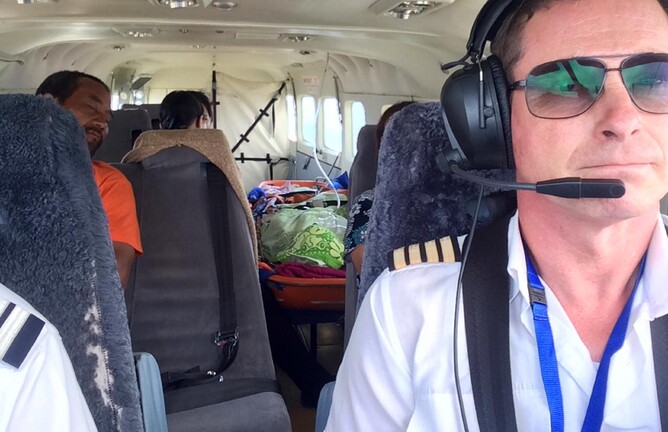Before noon on Saturday, we received a call for urgent medevac flight. A 13-year old boy called Baasandorj had been severely injured as a result of falling off a racing horse during the annual Mongolian festival Naadam.
Naadam is a traditional multiple-day annual festival celebrated in Mongolia. The festival is held in July and originates from the times of Genghis Khan. The main event is held in Ulaanbaatar (the capital), but each district capital and village holds its own local Naadam. The festival includes various cultural, music and other art performances. The main focus of Naadam is on three sports: archery, wrestling and horseback racing. The horse-racing track is laid across open terrain with a length of 15-30 kilometers, depending on the age of a horse. Riders are boys between ages of 5 to 13. According to local custom, they usually ride without shoes, saddle or any protective equipment, which poses certain risk to riders. Mongolian riding horses are designated to their purpose. They are fed on special diet and winner horses are very expensive. This is the ultimate Mongolian sport.
Our team quickly assembled in the office to start preparations for the flight to take place the same day. The boy had a head trauma and was unconscious. A 750 kilometer road trip from the mountainous town of Tosontsengel was no option. The town has a gravel airstrip, which is regularly used by MAF. Other regular flights to Tosontsengel ceased long ago.
The team was busy in making preparations, coordinating the flight with hospitals and doctors and filing paperwork, checking the weather and ensuring that we had adequate fuel for the flight. Weather looked troublesome in Ulaanbaatar, with ominous dark clouds and potential thunderstorm activity, but the forecast looked favourable.
In the course of preparations we learned that the boy's falling off a horse had created a lot of attention in the local media, both in social media and television. In the afternoon we took off from Ulaanbaatar with two local doctors. The aircraft had been prepared with a stretcher on board and five passenger seats to accommodate the doctors and accompanying family members.
There was a lot of weather around Tosontsengel, with heavy rains and lightning. Fortunately, the weather was far enough out to not cause any problems for approach or landing. The flight had taken two hours and twenty minutes. When arriving, we found out that the patient was not ready. The boy was still in the local hospital. A problem was that we were to start loading the patient in forty minutes' time. To make it back to Ulaanbaatar the same day, we had to comply with rules for being on the ground well before sunset. The doctors hurried off to the hospital to get the patient as quickly as possible. We stayed with the aircraft, adding fuel and getting updated weather information.
Just as it started looking that we might need to stay overnight at Tosontsengel and delay the flight until the morning, we saw a four wheel drive bouncing on the gravel road and across the bridge leading to the airfield. The doctors and family members started moving the injured boy, Baasandorj, from the back seat of the vehicle to our basket stretcher. The boy was unconscious and he apparently had trauma on his head and neck injuries. His body was wrapped in a blanket and his head was immobilised with a neck support. We were in a hurry to get airborne fast. At the same time, it was necessary to handle the boy very carefully and delicately to prevent further injury.
We managed to load the patient. As my radio-operator Baatarsukh was still busy securing the patient and passengers with seat belts, briefing them for the flight and getting oxygen supply connected, I moved on with take-off preparations, started the engine. While Baatarsukh was climbing from the passenger section to his right-hand seat, I was manoeuvring the aircraft ready for a line-up position. The weather had moved away further and we had a clear sky ahead for two hours to Ulaanbaatar. Fortunately, we had a favourable wind and managed to complete the flight just on time. It would have been very unfortunate to have to stay in Tosontsengel for a night since the boy was in such a critical condition. On arrival to Ullanbaatar, we were met by an ambulance and doctors, who commended Blue Sky Aviation for an excellent job. Baasandorj was quickly rushed to the ambulance and advanced care.
We learned later that Blue Sky Aviation had been praised in the aftermath discussions on social media and websites. People may ask, “Why do we engage in activities like this?” We are called to save lives. This is one of the important practical ways to convey love and care for Mongolians.
